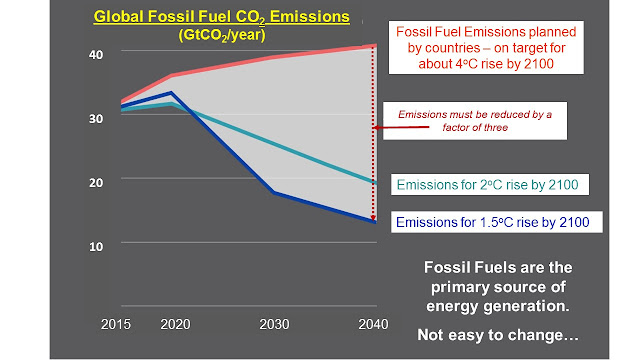It was a pleasure to talk to the Scottish branch of the Women's Engineering Society on Sunday 31st August about Climate Change - where we are just now and what might be happening in the coming decades? In the following, I am publishing the slides used for the talk with some minor additions. Virtual meetings provide welcome break from the isolation created by Covid-19; I believe that this is a great way to communicate science in the community and I hope to use this medium much more in the future.
The slides form the complete
talk. Commentary between the slides provides further explanation and the
links are generally to websites where more detailed discussion of the topic is
available.
Please click on a slide to see
its full page image
Slides:
The indicators point to a warming world. For example, water expands when heated. An increase in the sea surface temperature will result in increased volume of water, and sea levels will rise. Similarly global warming will result in a loss of ice in the Arctic Ocean and from the ice caps on mountains where ice will melt due to higher temperatures. Note that mountain ice-melt provides fresh water for drinking and irrigation to a large fraction of the world population and if these glaciers eventually disappear then it will be catastrophic for people downstream - it is expected that by the year 2100, the glaciers in the Himalayas will be reduced to one third of their present size - 2 billion people depend on the fresh water from the glaciers.
While the rich countries caused most of the emissions, the fast developing economies of China, India, Brazil and others are consuming resources at a higher rate than before - these countries represent a much larger population block and it seems unlikely that consumption and hence emissions will start to go down anytime soon.
While solar and wind are the most promising alternative energy technologies just now, and they have helped to cover the additional global energy demand of the past decade, it is difficult to see how they can replace fossil fuels to meet the full global energy use. Both solar and wind are excellent for producing electricity - but technologies need to be developed for electrification of transport, manufacturing etc.




Climate
change has never been taken seriously by most world governments, and suitable
actions were not taken in time to control climate change and mitigate its worst
effects. Even now, when it is obvious that the effects of global
warming are seen in frequent weather events, loss of ice sheets in Greenland,
sea level rise etc., there is no indication that climate change is being taken
seriously - one needs to consider the situation as climate crisis, and treated
as such. The example of the ongoing Covid-19 pandemic stands out when the
world governments quickly found 10 to 15% GDP to fight the pandemic.
Twenty years ago, spending 1% of GDP would have been sufficient to control and
mitigate the effects of climate change.
Similarly, good education about climate
change would create much needed awareness among the general populations, and
they will be more motivated to change their lifestyles and consumption
habits. No serious action by the people in power has been apparent and
valuable time is being lost. The longer we wait for sensible actions to
start, the more extreme and costly measures will be needed. There is no
sign that things are going to change soon.
One might feel that technology will
help to solve any difficulties that climate change might present in the
future. After all technology has always come to rescue in the past. I
hope things turns out to be this way - although it would be far better if one
could approach the looming threat of climate crisis in a rational way. There is
too much at stake.



























No comments:
Post a Comment